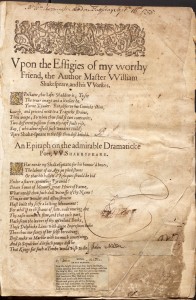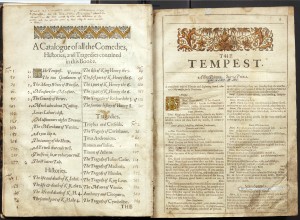We are exceedingly pleased to announce our acquisition of the so-called “Second Folio” of Shakespeare, which came from a Rhode Island family in whose possession it has been since the Civil War.
There were four (4) folio editions of the collected plays of Shakespeare produced in the seventeenth century. The celebrated “First Folio” (1623) was the first edition. Eighteen of the plays had never been printed before, including Macbeth, Twelfth Night, Antony and Cleopatra, and The Tempest.
 The “Second Folio” was printed when the First sold out, and is principally famous for the dedicatory poem to Shakespeare written in 1630 by John Milton—which was his very first publication of English verse (he was 24). There are over 170 copies recorded in American institutions, 57 of which are in the Folger Shakespeare Library (Washington, DC). The “Third” (1664) and “Fourth” (1689) folios contained seven extra plays, of which only Pericles is now considered to be Shakespeare’s.
The “Second Folio” was printed when the First sold out, and is principally famous for the dedicatory poem to Shakespeare written in 1630 by John Milton—which was his very first publication of English verse (he was 24). There are over 170 copies recorded in American institutions, 57 of which are in the Folger Shakespeare Library (Washington, DC). The “Third” (1664) and “Fourth” (1689) folios contained seven extra plays, of which only Pericles is now considered to be Shakespeare’s.
The First Folio is one of the most studied books in English literature, and so it (and its successors) are excellent tools to use to teach students about print culture in early modern England. Purchasing a First Folio is generally not possible for institutions like Trinity, since the going rate for a complete copy in good condition is roughly $5 million. However, the latter Folios are sometimes within reach, especially (as with this copy) if it lacks a few key leaves, such as the title-page and the portrait of Shakespeare. These, however, can be supplied in facsimile. Milton’s dedicatory poem and all of the plays are present.
 This particular copy is fascinating because of what generations of owners have done with (and to) it. At least two former owners were women–one of whom (“Mary Wright”) dated her signature “1716”. There are other names written in the book, as well as plenty of manuscript marginalia (including a transcription of Shakespeare’s will, lists of actors, and comments on the texts). At the end, there are also clippings from newspapers and sections of later editions of certain plays (Hamlet, Macbeth, King Lear, and Richard III).
This particular copy is fascinating because of what generations of owners have done with (and to) it. At least two former owners were women–one of whom (“Mary Wright”) dated her signature “1716”. There are other names written in the book, as well as plenty of manuscript marginalia (including a transcription of Shakespeare’s will, lists of actors, and comments on the texts). At the end, there are also clippings from newspapers and sections of later editions of certain plays (Hamlet, Macbeth, King Lear, and Richard III).
As one faculty member put it in a letter supporting the purchase, “We could all quite easily use it as a pedagogic tool, a text to share with students of all levels as we teach our various courses on early modern literature and culture, Shakespeare, and the history of the book. Undergraduates understand full well the cultural centrality of Shakespeare; they are often surprised and interested to find out how the significance of Shakespeare’s plays has been imagined and reimagined not only on the stage but also on the page. This specific copy of Shakespeare’s Second Folio seems a particularly rich and interesting acquisition in this regard. As a material artifact filled with marginal comments by readers, it bears witness not only to the monumentalizing ambitions of Shakespeare’s seventeenth-century publishers but also to the shifting ways in which Shakespeare’s work has been read and interpreted over time.”
Many, many thanks to members of the Watkinson Board of Trustees and the administration of Trinity College for their generous support, without which this acquisition would not have been possible!
